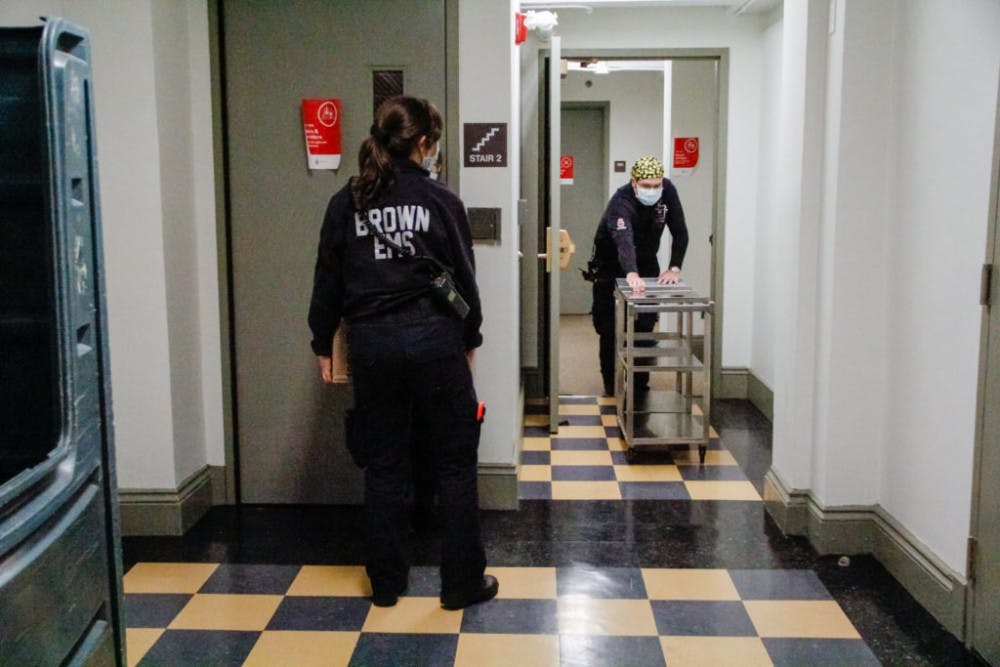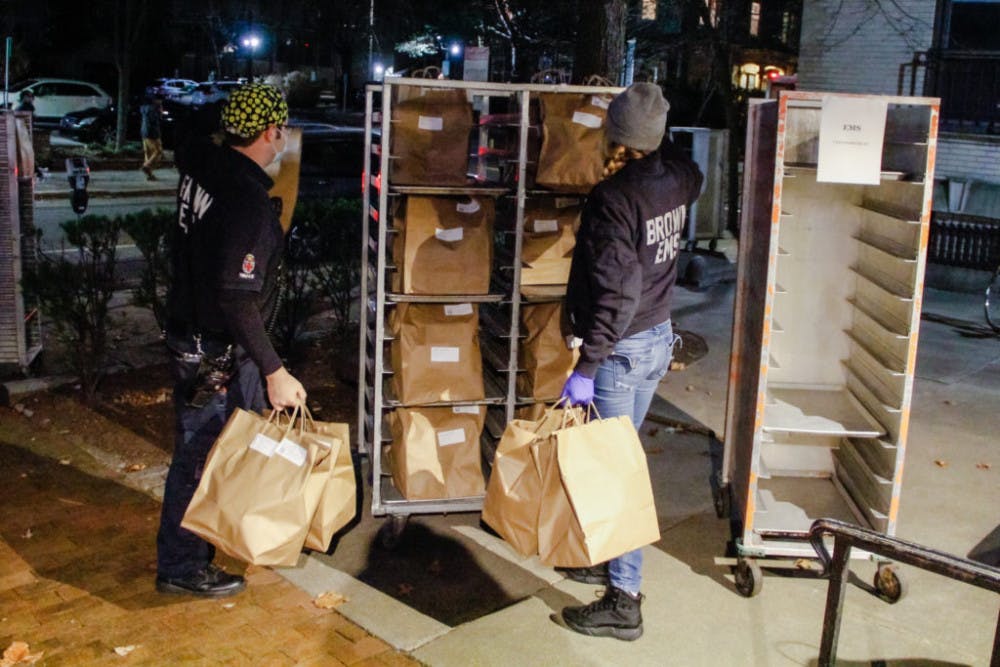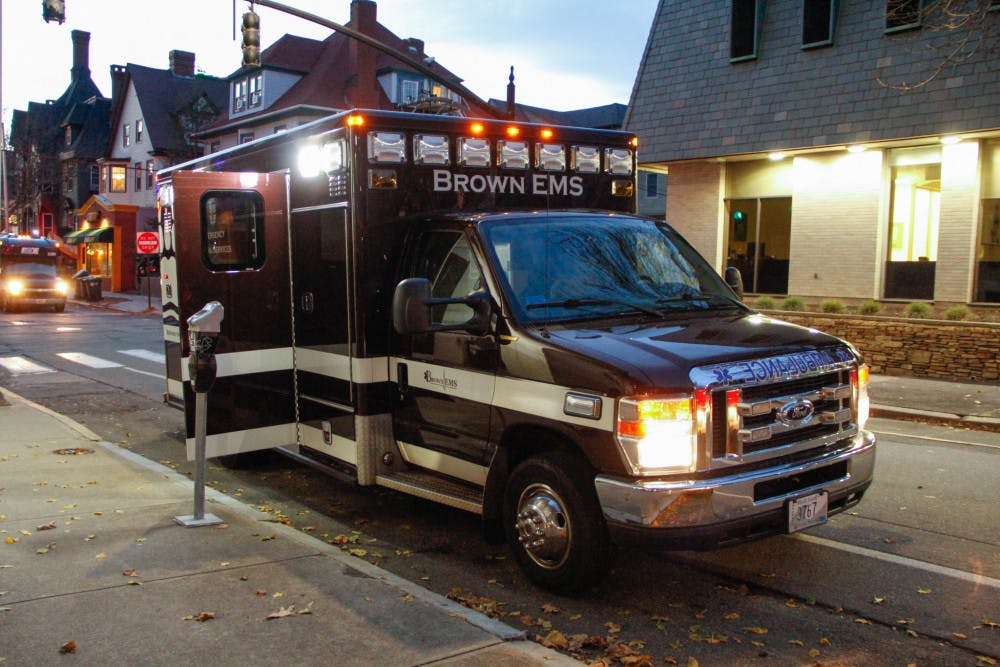Vivian Van ’21 rests in her official dark-blue Emergency Medical Services uniform, which matches the sky in the backdrop of the window behind her. It’s past midnight, but she’ll be ready to respond if there is an emergency call. The clock ticks onward, pushing into her 12-hour shift.
A COVID red comes in — a call for a person experiencing COVID-19 symptoms.
An experienced Advanced Life Support colleague, who is equipped to provide advanced, life-saving care, joins her from an adjacent room. At this time last year, a group of EMTs, supervisors and recruits in training would be dashing out the door of EMS headquarters. Now, it’s just the two of them, new recruits noticeably absent.
Van, a Basic Life Support supervisor, climbs into the ambulance and slips on her seatbelt in the driver’s seat as her non-student colleague assumes the risk by preparing to attend to the incoming patient.
The ALS member is clad in the proper protective equipment: body garbed in gowns and gloves, face warmed by their breath insulated underneath a mask, moonlight reflected off their face shield. Van will not be interacting with the patient directly, but mirrors her colleague in appearance with her eye protection, gloves and mask.
Forty two years after its founding, Brown EMS sirens still blare from its headquarters during the day, and its signature red and white hue whizzes across the backdrop of dorms throughout the nights. Formed amid the Great Blizzard of 1978, Brown EMS finds itself once again responding to the call of a community-wide problem: COVID-19.
BEMS’ purpose to care for their patients has not faltered. “It’s still the same words that we say when we go into the room, we just might be wearing more on our bodies,” said Emily Pham ’21, training officer and Basic Life Support supervisor at EMS.
But the pandemic has challenged first responders to rethink how they approach their roles while ensuring the comfort and safety of their staff.
Shifting priorities
BEMS operates 24/7 and relies on the time and commitment of students like Van and other more experienced staff, including medical students, to administer direct patient care and attend to tasks such as handling private medical information, according to Director of Emergency Management for Health and Wellness Amy Sanderson.
While making changes to ensure the safety of their staff, BEMS “gave students the opportunity to continue their clinical work and the work that they really love doing for the campus, and to expand those opportunities to other people who were less comfortable actually working on the ambulance,” Sanderson said.
BEMS staff have continued with traditional responsibilities like administering flu shots, though they are not delivering any COVID-19 tests, Sanderson said. This semester, BEMS workers have also coordinated with dining services to deliver meals, mail and school, self-care and home supplies to students in isolation. An EMT stays in buildings where students are isolating “every night to be a warm presence” and to offer support or guidance to further resources, Sanderson said.
[caption id="" align="aligncenter" width="650"]

To ensure proper preparation and safety in responding to calls, patients are asked about their symptoms, temperature and COVID-19 test results, among other questions, before EMS personnel are sent out to them, Van said. If the case is marked COVID green, meaning it is not determined to not be a COVID-19 risk, responders are required only to wear masks, gloves and goggles in an effort to conserve personal protective equipment during the ongoing shortages.
Nevertheless, staff are “always encouraged to wear the PPE that we feel comfortable providing care” in, she added. Van and Pham both said they felt safe while working on EMS.
Pham said that she trusted the University to support BEMS workers through Brown’s COVID-19 testing plan, adding that she felt more comfortable in her work since she primarily interacts with University students and staff.
BEMS also continues to bring students back from the hospital or transport them to isolation residences on campus, which BEMS manages with University Health Services. During the summer, they had helped drive symptomatic students to Rhode Island Department of Health COVID-19 testing sites before an on-campus testing site was established this fall.
For transport, BEMS has also been utilizing their “COVID car” — a vehicle that has been repurposed so it can now legally be used to drive people, Sanderson said. This change has enabled the team to respond to more calls at the same time.
While BEMS traditionally operates as a volunteer service for undergraduates during the school year and a paid job during breaks, all staff who consented to assist during the pandemic are being paid. But the opportunity to help the community in a clinical as well as nonclinical capacity, albeit through brief interactions, is rewarding in itself.
When coordinating non-clinical responsibilities, such as dropping off deliveries to students in quarantine, “usually (the EMS member is) the first human interaction that person’s going to have for the next X amount of days for the time they’re isolated,” Van said, “so, you want to be as warm and friendly as possible while being of course socially distanced.”
Pham has enjoyed these non-clinical opportunities. The “best feeling about that is when someone replies to the door knock and is like, ‘Thank you!’” she said. “It’s not just delivering food,” she added, it’s “showing people that you care.”
[caption id="" align="aligncenter" width="650"]

Recruits are also permitted to help out through these non-clinical means.
This is not the first time BEMS has had to prepare to respond to a public health threat. When Ebola cases had turned up in the United States back in 2014, “We never had to deal with it directly in Rhode Island, but we were ready,” Sanderson said. “I really channeled that lesson” at the time of COVID-19, she added.
In this context, considering student members’ academic obligations alongside high quality service “is a real balancing act in the collegiate EMS service,” Sanderson said. “EMS is always a dangerous job, and then you add to that the exposure risks in the time of a pandemic, and it needs very careful planning.”
These unexpected scenarios emphasize the importance of BEMS’ standard goals: “being scalable, innovative, meeting the needs of a community, considering equity (and) cultivating equity,” Sanderson said.
BEMS has “been looking for ways that we can be a part of the greater Brown community,” Pham said. The pandemic “was a catalyst for us to get there, and I think we’re making a real impact.”
Pham is “really glad that Brown as a University is still allowing us to work and trusting us,” and she has found “great value” in helping fellow students at this uncertain time.
“Doing all these nonclinical shifts or tasks (has) actually made me realize that there’s many many ways to help someone rather than just fulfilling their clinical needs,” Van said. Acting as a “warming presence for someone who’s undergoing not a great time in their life, it brings me back to why I became an EMT ... to provide patient advocacy, being there for the patient.”





